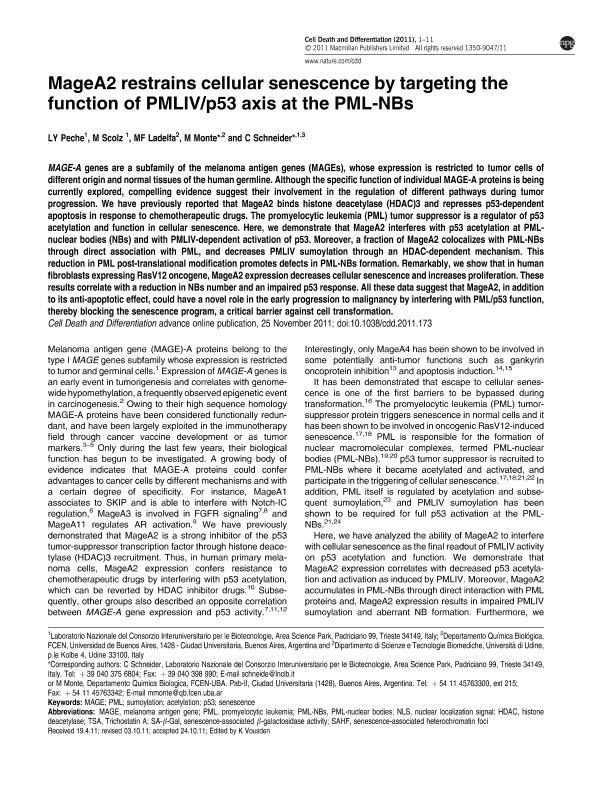Artículo
MageA2 restrains cellular senescence by targeting the function of PMLIV/p53 axis at the PML-NBs
Fecha de publicación:
06/2012
Editorial:
Nature Publishing Group
Revista:
Cell Death and Differentiation
ISSN:
1350-9047
Idioma:
Inglés
Tipo de recurso:
Artículo publicado
Clasificación temática:
Resumen
MAGE-A genes are a subfamily of the melanoma antigen genes (MAGEs), whose expression is restricted to tumor cells of different origin and normal tissues of the human germline. Although the specific function of individual MAGE-A proteins is being currently explored, compelling evidence suggest their involvement in the regulation of different pathways during tumor progression. We have previously reported that MageA2 binds histone deacetylase (HDAC)3 and represses p53-dependent apoptosis in response to chemotherapeutic drugs. The promyelocytic leukemia (PML) tumor suppressor is a regulator of p53 acetylation and function in cellular senescence. Here, we demonstrate that MageA2 interferes with p53 acetylation at PML-nuclear bodies (NBs) and with PMLIV-dependent activation of p53. Moreover, a fraction of MageA2 colocalizes with PML-NBs through direct association with PML, and decreases PMLIV sumoylation through an HDAC-dependent mechanism. This reduction in PML post-translational modification promotes defects in PML-NBs formation. Remarkably, we show that in human fibroblasts expressing RasV12 oncogene, MageA2 expression decreases cellular senescence and increases proliferation. These results correlate with a reduction in NBs number and an impaired p53 response. All these data suggest that MageA2, in addition to its anti-apoptotic effect, could have a novel role in the early progression to malignancy by interfering with PML/p53 function, thereby blocking the senescence program, a critical barrier against cell transformation. © 2012 Macmillan Publishers Limited. All rights reserved.
Palabras clave:
Acetylation
,
Mage
,
P53
,
Pml
,
Senescence
,
Sumoylation
Archivos asociados
Licencia
Identificadores
Colecciones
Articulos(IQUIBICEN)
Articulos de INSTITUTO DE QUIMICA BIOLOGICA DE LA FACULTAD DE CS. EXACTAS Y NATURALES
Articulos de INSTITUTO DE QUIMICA BIOLOGICA DE LA FACULTAD DE CS. EXACTAS Y NATURALES
Citación
Peche, L. Y.; Scolz, M.; Ladelfa, Maria Fatima; Monte, Martin; Schneider, C.; MageA2 restrains cellular senescence by targeting the function of PMLIV/p53 axis at the PML-NBs; Nature Publishing Group; Cell Death and Differentiation; 19; 6; 6-2012; 926-936
Compartir
Altmétricas




